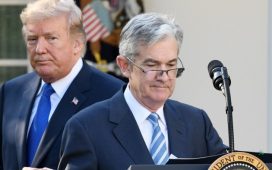This article is an on-site version of our Unhedged newsletter. Sign up here to get the newsletter sent straight to your inbox every weekday
Good morning. You write one little newsletter about how the economy is finally in a good spot, and somebody has to come along and mess it up: oil passed $90 a barrel yesterday, after the Saudis and Russians announced extensions to their production cuts. What did we ever do to them? If you think more expensive energy is a real threat to growth, email us: robert.armstrong@ft.com and ethan.wu@ft.com.
Is Goldilocks out of the woods?
Rob wrote yesterday that in the face of nicely balanced economic data, it was time to smile, dammit. And we are smiling. Finding reasons to worry takes work right now. But if we were to worry about something — we are financial journalists, after all — it would be that today’s Goldilocks combination of good growth, low unemployment and falling inflation may be an unstable equilibrium.
The economy looks like it is getting back to normal, with inflation and employment close to their pre-pandemic levels. Booming consumption, on the other hand, does not look quite so normal. If people are spending loads more on real resources, one of three things has to happen: either the supply of those resources has to rise, inflation has to go up, or consumption must cool off. Which will it be?
Start with some facts. The reliably informative quits rate, at 2.3 per cent, is right back where it was in 2019. Labour force participation has recovered, too. The gap between the number of jobs (employment + job openings) and available workers is shrinking rapidly. Goldman Sachs’s measure of this “jobs-workers gap” is less than 1 percentage point above late 2019 levels, compared with a peak of 3 percentage points last year. Wage growth is elevated but slowing.
Spending, meanwhile, is charging rabidly ahead. Real consumption is growing at 3 per cent year on year. Services spending keeps growing steadily. Real spending on goods, which has been flat for a year after the pandemic goods binge, appears to be rising again:

This dynamic — a slowing labour market and strong consumption — can be read at least three ways:
-
Consumer spending must deteriorate. Consumption rose faster than disposable income in July, and borrowing is on the rise. Car loan and credit card delinquencies are surging. That is happening from historically low levels, but what’s to stop a further rise? Student loan payments will kick in soon, too. As the job market cools off, spending will fall.
-
A gentle normalisation process is happening. Supposed signs of deterioration in labour markets and consumer health are just reversions to 2019. This includes rising delinquencies, slowing payrolls growth and a falling number of temporary workers. Today’s slowing labour market plus sturdy consumption is the opposite of a normal late-cycle story (where a weakening economy foretells troubles in the labour market), points out Omair Sharif of Inflation Insights. More plausible, he thinks, is an unwinding of pandemic employment anomalies.
-
The risk of inflation getting stuck above 2 per cent is growing. The labour market, though cooling, is by most measures strong, adding fuel to the spending fire. Rising consumer debt burdens don’t look like a big threat, either. For example, the return of student loan payments will shave just 0.3 per cent (or $70bn) off disposable income, estimates Goldman. Broad measures of financial stress remain near all-time lows. The real risk is that hard-charging consumers push through these mild headwinds, overwhelming supply in areas such as cars. Inflation might then stay too high.
Interpretation 3 worries us most because it rhymes with what has already happened this cycle. It doesn’t require you to bet against the consistently resilient US consumer, or against labour market strength. Rather, it’s a bet that the inflation regime changes more slowly than any of us would like. Interpretation 2, we admit, looks attractive. But the risk of wishful thinking remains. (Ethan Wu)
I find this chart pretty remarkable:

Since the market bottomed last October, industrials have slightly outperformed the wider US stock market (this is not a calendar anomaly: the performance of industrials has kept pace with the wider market since the start of the pandemic).
Why is this remarkable? Reading financial headlines over the past year or so, you would have thought that any sub-index that did not contain Nvidia and the other big tech stocks would have to underperform. But a bunch of big industrial stocks including GE, FedEx, Parker Hannifin and Caterpillar have staged remarkable runs (those four have returned 126, 73, 70 and 64 per cent since last October 10 2022, respectively). The strong performance is broad-based: of the 75 stocks in the S&P 500 industrials sub-index, 45 have returned 20 per cent or more, and only eight have posted negative returns.
It makes perfect sense that economically-sensitive industrials would outperform in the period when the recessionary narrative was giving way to expectations of a soft landing. But it is surprising — it surprises me, at least — that the performance has remained strong in recent weeks, as evidence has mounted that the economy, while not dropping into recession, is cooling. A note from Jason Draho at UBS yesterday sums up the sentiment nicely:
Regardless of what 3Q GDP tracking estimates say, inflated as they are by Barbenheimer, Taylor and Beyoncé, the US economy is slowing. The most compelling and relevant evidence for that claim is from the labour market, and the data last week makes it hard to dispute. Monthly job growth has been gradually declining for more than two years, while the fall in job openings appears to have picked up pace. Other data tell a similar story of a cooling labour market. Given these trends, any thoughts of a “no landing” can be put to rest.
That’s the mood. And yet industrial stocks, which are cyclical enough to come down with a thump even in a soft landing, have churned ahead. What to make of this? Are industrials telling us that fears of an economic slowdown have been over-egged? Or are the stocks riding on momentum and set to disappoint?
The financial performance of the group has returned to something like normal since the pandemic. Margins never blew out, as they did for some other groups, and revenue growth in the latest quarter was about 6 per cent (on a non-weighted average of all the companies), in line with both nominal GDP and pre-pandemic levels.

Yin Luo of Wolfe Research, who focuses on quantitative analysis of factor and sector performance, has been surprised by how well cyclicals in general have held up. He thinks economic growth that continues to surprise, strong company fundamentals, and reasonable valuations have all helped — but the macro slowdown will tell on the sector eventually. He therefore has doubts about the strong relative performance continuing. This view has the advantage of simplicity: industrials are economically sensitive, the economy is slowing, so the strong relative performance probably won’t last.
Others think there is more to the story. Mike Wilson of Morgan Stanley suggests owning industrials. He, too, notes the strength of company performance and attractive valuations, but adds that late in economic cycles, industrials outperform other economically sensitive stocks in general, and consumer discretionary stocks in particular. This makes sense, inasmuch as industrial companies are more insulated from quick changes in consumer sentiment, and that late in a cycle people get jumpy. His chart:
There is, however, a sting in the tail of Wilson’s bull case for industrials. The circle will turn down eventually, and this is liable to happen suddenly:
It’s very difficult to call the end of the business cycle. These periods are elusive right until the moment when activity seems to stop on a dime. They are also typically accompanied by an “event” that is just too much for the economy to handle in its already weakened state.
The problem with industrials, in other words, is knowing when to sell (as the chart shows quite well). No one is going to ring a bell.
Scott Chronert of Citigroup is bullish on cyclicals broadly and industrials specifically. He thinks as the industrial economy incorporates more technology, it becomes less cyclical:
The US industrial economy will continue to incorporate technology, including artificial intelligence, robotics and automation, in ways that gradually lessen the inherent susceptibility to broader swings in economic activity and certain input costs.
Earnings declines of cyclical stocks during moments of economic contraction have been growing smaller, relative to the broad market, since the oil collapse of 2015. And in the post-pandemic boom, cyclicals’ profit margins have risen to the levels of the wider market, reflecting the changes wrought by technology.
I think Chronert’s thesis is intriguing, but I don’t buy it. I doubt that it is possible to see through the economic oddities of recent years to secular changes in the economy. I put my doubts to Chronert and he responded as follows:
No doubt, there is an element of lingering post-pandemic effects. It will be difficult to prove lesser cyclicality until we get through an entire cycle. Nevertheless, that margins have held this well even as industrial production is now at levels normally associated with recessions is a positive step.
As the second chart above shows, industrials’ margin steadiness in the face of slowing growth and higher input costs has been remarkable, and calls out for an explanation. But without other evidence, the default assumption has to be that a downturn will — in time — hit industrials’ profitability just as hard as it has in previous cycles.
To sum up. Industrials’ financial and market performance is another reminder that we are still in a remarkably strong economy; there is some reason to expect the solid performance to persist through the late part of the cycle; but cycles most often end with a bang, not a whimper.
One good read
Robin Harding on the global problem of weak Chinese demand.
FT Unhedged podcast

Can’t get enough of Unhedged? Listen to our new podcast, hosted by Ethan Wu and Katie Martin, for a 15-minute dive into the latest markets news and financial headlines, twice a week. Catch up on past editions of the newsletter here.










